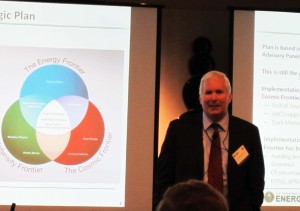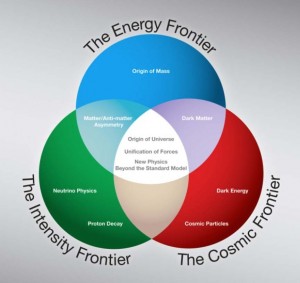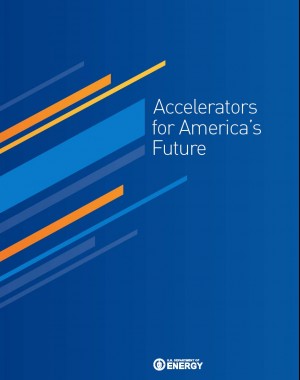As US Regional Director, Mike Harrison usually covers US High Energy Physics Advisory Panel (HEPAP) meetings as a way to stay abreast of developments in and the direction of the US high-energy physics programme. This time, instead of Mike, I attended the recent HEPAP meeting in Washington DC on 12 and 13 March. At this meeting, HEPAP dealt with US high-energy physics budgets, including future year projections, and how to reconcile these with the ambitions of the US high-energy physics programme. Today, I summarise some highlights from this meeting.
HEPAP is jointly chartered by the US Department of Energy (DOE) and the National Science Foundation (NSF) under the guidelines established by the Federal Advisory Committee Act to provide periodic reviews of existing high-energy physics programmes; provide advice on the formulation of long-range plans, priorities, and strategies for the nation’s high-energy physics programme; recommend appropriate levels of funding to assure a world leadership position; and make recommendations to help maintain appropriate balance between competing elements of the programme. Thereby, HEPAP is the official advisory committee to the US funding agencies for high-energy physics.
For the DOE, Bill Brinkman, Director of the Office of Science, presented the “Fiscal Year 2013 Budget Request to Congress for DOE’s Office of Science.” The Office of Science provides 45 percent of the federal support of basic research in the physical and energy-related sciences. Brinkman emphasised that the Office of Science underpins the President’s goals, including clean energy, new materials design and discovery, biological and environmental research and advanced scientific computing research. As a result, the small (roughly two percent) increase for the Office of Science for FY2013 has gone into these fields, leaving other areas, like high-energy physics, with near constant budgets.
Jim Siegrist, Associate Director for High Energy Physics, followed by summarising the programme for high-energy physics within the FY2013 budget request to Congress. Of course, of special interest to those of us in the ILC is that this budget request both recognises the success of our programme and the planned completion of the TDR at the end of this year. However, the proposed budget requested no new funding for the ILC post-TDR programme. Siegrist addressed the future support for the ILC as follows: “We will keep a VERY low-level GDE involvement while we wait to see if another region will press forward with a project.” As a result, we are working hard in the short term to make sure we have enough resources to complete the ILC Technical Design Report and to ensure that the critical ongoing R&D will have no major interruptions.
The US programme in particle physics is now being treated as three efforts at the three frontiers of particle physics that were introduced in the HEPAP P5 report. The figure from that report has even become an icon representing the field of particle physics. There was considerable emphasis in this HEPAP meeting on the US programme at the Intensity Frontier.
The proposed centrepiece of this activity for the future is a redirection of the activities at Fermilab. Again quoting Jim Siegrist, “Fermilab is the HEP main laboratory. Our first priority is to increase capability investment at Fermilab to support our future Intensity Frontier programme while keeping all three frontiers in balance. Fermilab must concentrate efforts in this area, and the rest of the community needs to support that mission where appropriate (including the other labs). The Fermilab Long Baseline Neutrino Experiment (LBNE) is presently under consideration at the Office of Science as to whether they can integrate it into their future programme at its present scope with anticipated future flat budgets.” A decision was announced soon after the HEPAP meeting that the proposed budget for LBNE cannot be accommodated and ways will need to be considered to reduce the scope of the project.
Another presentation of special interest was given by Norbert Holtkamp on the “Accelerator Task Force Interim Report to HEPAP.” The background is that DOE sponsored a workshop called Accelerators for America’s Future in 2009 to elicit views and opinions on the challenges and opportunities for developing and deploying accelerators to meet the national needs.
As a result of that workshop and report, which can be downloaded from the Accelerators for America’s Future website, the Senate has directed the Department “to submit a 10-year strategic plan by June 1, 2012 for accelerator technology research and development to advance accelerator applications in energy and the environment, medicine, industry, national security, and discovery science. The strategic plan should be based on the results of the Department’s 2010 workshop study, Accelerators for America’s Future, that identified the opportunities and research challenges for next-generation accelerators and how to improve coordination between basic and applied accelerator research. The strategic plan should also identify the potential need for demonstration and development facilities to help bridge the gap between development and deployment.”
Holtkamp gave an interim report for the group of senior accelerator scientists from a broad range of laboratories who have been charged with developing a response to the Senate directive. The committee is considering the question very broadly, including questions of how to organise such an effort, what the key technical challenges in the field are and how to integrate industry into accelerator developmental work in DOE labs. They have even developed some preliminary infrastructure proposals:
- Infrastructure Proposal 1
“The medical community would benefit from a discussion of how the current R&D program could help on the route to a National Resources for Hadron Beam Medical Facilities. The Office of Science could develop a stepwise implementation plan for providing beams, developing beams and beam delivery systems for a cost-efficient production of such facility.” - Infrastructure Proposal 2
“The Office of Science could consider providing a home for laser R&D under its auspices. Lasers, an enabling technology, have become an integral part of accelerators and provide tremendous potential for new methods of acceleration, for miniaturization of accelerators and as part of accelerator systems.”
In his summary, Holtkamp solicited advice on feasibility, appropriateness and content, and emphasised that implementing some of the ideas they are considering would mean changing how we do business.





Recent Comments